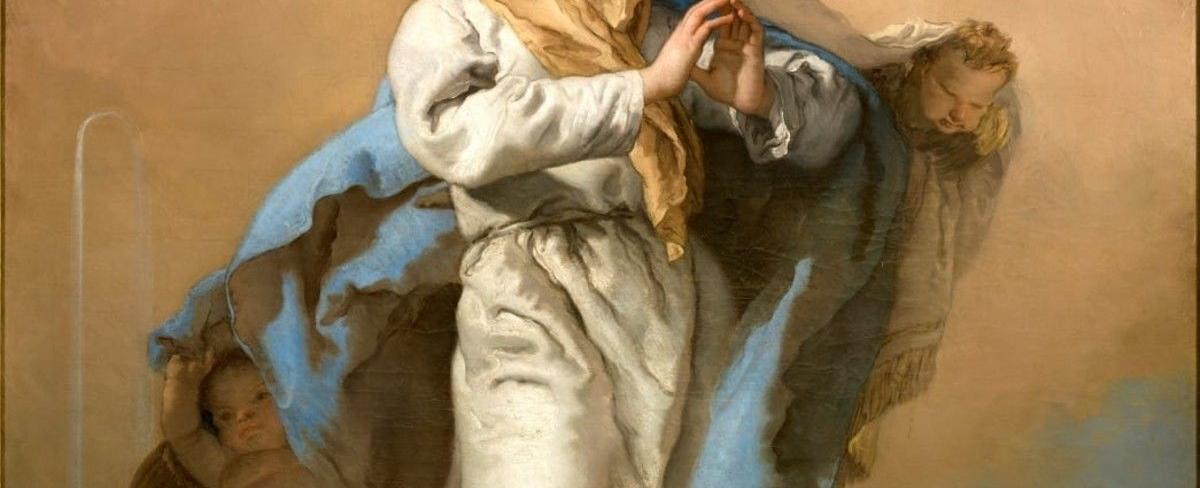Solemnity of the Immaculate Conception of the Blessed Virgin Mary: The Franciscan Connection

On December 8, the Church celebrates the Solemnity of the Immaculate Conception of the Blessed Virgin Mary, especially significant for Franciscans, as under this title we honor Mary as patroness of our Order. Mary is also venerated under this title as patroness of the United States of America, the Philippines, and a number of other countries.

Basilica of the National Shrine of the Immaculate Conception, Washington, DC. In 1846 the bishops of the United States unanimously voted to proclaim Mary, under the title of the Immaculate Conception, as patroness of the United States, and this was approved by Pope Pius IX in 1847. Construction on this national shine began in 1920, and the upper church was completed in 1959. Work still continues on the interior.
Francis sees Mary as God’s grace in the world
Francis himself was especially devoted to Mary, seeing in her the prime manifestation of the working of God’s grace in the world. He prays to her in his “Salutation”: “Hail, O Lady, Holy Queen, Mary, holy Mother of God, who are Virgin made Church, chosen by the most Holy Father in heaven, whom he consecrated with His most holy beloved Son and with the Holy Spirit the Paraclete, in whom there was and is all fullness of grace and every good.”

The column of the Immaculate Conception in Rome, near the Spanish Steps, was erected in 1857 to celebrate the definition of the dogma in 1854. Traditionally, the pope comes to ask Mary’s blessing on the city on this feast day, marking the beginning of the holiday season in Rome.
Franciscan John Duns Scotus’s theology of the Immaculate Conception
It was the Franciscan John Duns Scotus who finally developed the theological arguments that explained how Mary could indeed possess this “fullness of grace” by being preserved from all sin from the very first moments of her existence. For a detailed analysis of Scotus’s arguments in defense of the Immaculate Conception of Mary in the context of medieval theology, read an article by Noel Muscat, OFM.
Liturgical feast spreads around the world
Ever since 1477, the Franciscan Order has celebrated the liturgical feast of the Immaculate Conception, and it gradually spread to many other parts of the Church. Finally, in 1854, Pius IX, a Secular Franciscan, solemnly proclaimed: “The most Blessed Virgin Mary, in the first instant of her conception, by a singular grace and privilege granted by almighty God, in view of the merits of Jesus Christ, the savior of the human race, was preserved free from all stain of original sin.”

The Cathedral of the Immaculate Conception, Manila. The diocese was placed under the patronage of the Immaculate Conception in 1578. As a Spanish colony, priests in the Philippines were permitted to wear blue vestments on this feast, a privilege allowed to continue in 1910. In 1942, Pope Pius XII officially proclaimed the Immaculate Conception patroness of the Philippines. The current cathedral was rebuilt following its destruction in World War II.
Mary’s debt to God and her Son
As Mary Beth Ingham nicely summarizes the significance of this teaching: “Scotus argues that Mary’s innocence does not do away with her need for liberation. Rather, to be preserved from sin from the outset is a greater gift than when one sins and is restored to wholeness. In the Immaculate Conception, Mary’s debt to God and to her Son is the greatest debt of all: the debt of her full human dignity. This debt is repaid by human gratitude, the debt of love. . . In Scotus’s vision, it is the abundance of grace that takes center stage, a grace always at work in the created order, because God's loving presence is dynamic and life-giving.”

The National Shrine of Our Lady of Aparecida "Our Lady Revealed" in Brazil, originating in a local devotion to a miraculous statue of a black Mary of the Immaculate Conception found in 1717. This is the largest Marian shrine in the world, dedicated in 1980 and holding some 30,000 worshipers. Pius XI declared Mary under this title patroness of Brazil in 1930.
God’s grace triumphs over sin and death
What happened in Mary demonstrates that God’s grace is always prior to and eventually triumphs over the power of sin and death. May we all, like Mary, “fully welcome God and His merciful grace into our life” (Pope Francis).
Franciscans sing Marian antiphon
Dominic Monti, OFM
Professor of Franciscan Research in the Franciscan Institute of St. Bonaventure University
Dominic V. Monti, OFM, is a Franciscan Friar of Holy Name Province (USA) and currently professor of Franciscan Research in the Franciscan Institute of St. Bonaventure University. He devoted the greater part of his ministry to teaching the History of Christianity, in particular the history of the Franciscan movement. He has contributed two volumes to the Works of St. Bonaventure series and is author of Francis & His Brothers, a popular history of the Friars Minor.

